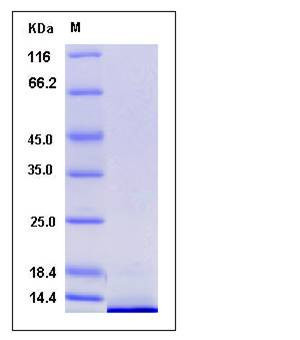Human CCL22 / MDC Protein (His Tag)
A-152E5.1,ABCD-1,DC/B-CK,MDC,SCYA22,STCP-1
- 100ug (NPP3551) Please inquiry
| Catalog Number | P10163-H07E |
|---|---|
| Organism Species | Human |
| Host | E. coli |
| Synonyms | A-152E5.1,ABCD-1,DC/B-CK,MDC,SCYA22,STCP-1 |
| Molecular Weight | The recombinant human CCL22 consisting of 84 amino acids and has a calculated molecular mass of 9.7 KDa. It migrates as an 10 kDa band in SDS-PAGE under reducing conditions. |
| predicted N | Met |
| SDS-PAGE |  |
| Purity | > 90 % as determined by SDS-PAGE |
| Protein Construction | A DNA sequence encoding the secreeted form of human CCL22 (O00626) (Gly 25-Gln 93) was expressed, with a polyhistidine tag at the N-terminus. |
| Bio-activity | |
| Research Area | Immunology |Inflammation / Inflammatory Mediator |Inflammatory Disorders Therapeutic Targets |Glomerulonephritis Therapeutic Targets |
| Formulation | Lyophilized from sterile 30% Acetonitrile, 0.1% TFA 1. Normally 5 % - 8 % trehalose, mannitol and 0.01% Tween80 are added as protectants before lyophilization. Specific concentrations are included in the hardcopy of COA. |
| Background | Chemokine (C-C motif) ligand 22(ABCD-1 / CCL22)is a kind of CC chemokine which is a family of secreted proteins involved in immunoregulatory and inflammatory processes. The cytokine displays chemotactic activity for monocytes, dendritic cells, natural killer cells and for chronically activated T lymphocytes. It also displays a mild activity for primary activated T lymphocytes and has no chemoattractant activity for neutrophils, eosinophils and resting T lymphocytes. This ABCD-1 / CCL22 chemokine binds to chemokine receptor CCR4. This chemokine may play a role in the trafficking of activated / effector T lymphocytes to inflammatory sites and other aspects of activated T-lymphocyte physiology. ABCD-1 / CCL22 is highly expressed in macrophage and in monocyte-derived dendritic cells, and thymus, and in Langerhans' cell histiocytosis and atopic dermatitis but not in dermatopathic lymphadenopathy. This chemokine is also found in lymph node, appendix, activated monocytes, resting and activated macrophages. This protein is lower expressed in lung and spleen and very weekly expressed in small intestine. |
| Reference |
